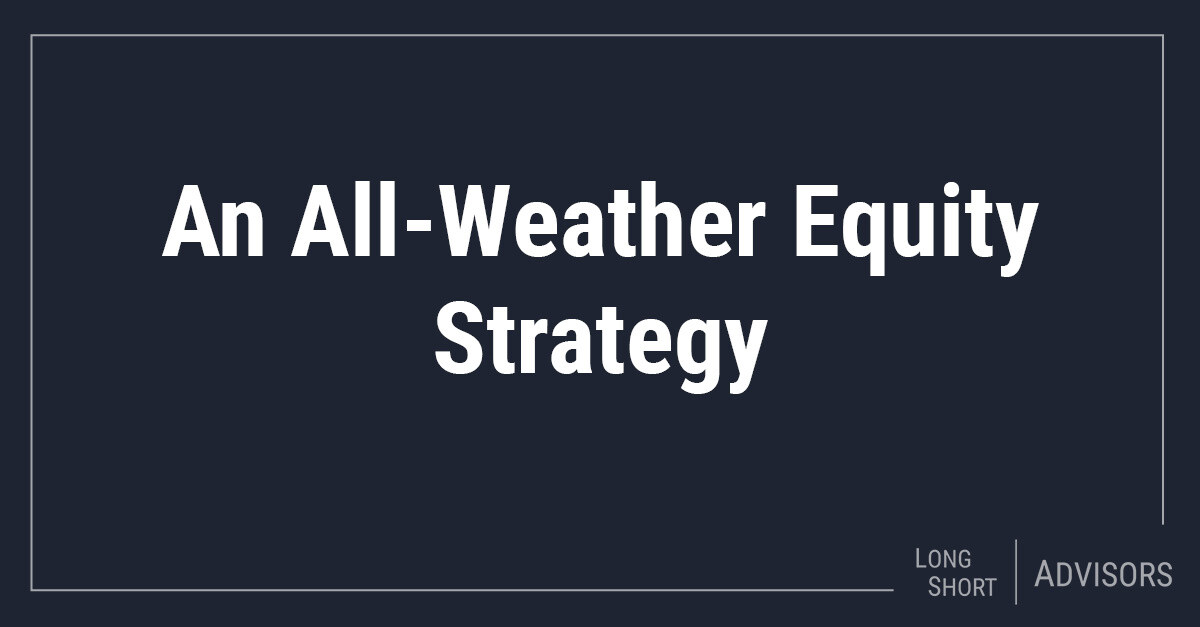An All-Weather Equity Strategy
The stock market has been on a tear recently, which makes this an opportune time to curb your enthusiasm, take a step back and consider whether your portfolio is sufficiently diversified and includes asset classes that can perform well in a multitude of potential future scenarios. After all, inflation is still not whipped; stock valuations, particularly for large-company equities, are at unusually high levels; geopolitical risk around the world seems elevated; and, since the economic cycle has not been repealed, there is always the potential for a recession down the road.
We can’t divine the future, but we can take steps to ensure that our portfolios are well-diversified and include allocations that can keep investors in stocks through bull and bear market cycles. One choice in the investor’s toolkit is a long-short strategy. Once the preserve of private hedge funds, long-short strategies are now readily available as regulated mutual funds with full market daily liquidity.
Before considering how a long-short equity strategy can be best deployed in a diversified investment portfolio, let’s briefly define and describe the strategy. In it, managers take long positions in company stocks that they expect to rise in value and sell short equities that they anticipate will fall in value. In other words, a skillfully run fund can generate profits on both long and short positions. The funds come in quite a variety of flavors (for instance, some but not all use leverage), but a typical long-short strategy will hold a 40% to 60% net long position. This modest sensitivity to beta (or equity market movements), along with risk mitigation through short positions, generally results in lower portfolio volatility and shallower drawdowns in bearish markets.
Playing Offense and Defense
An adroit investor will also generate alpha through skilled stock-picking on both the long and short sides. For example, a specialist in the financial sector can express positive views about financial companies that gain from higher interest rates and turmoil in the banking sector and negative views about stocks that are hurt by the same factors or otherwise suffer from deteriorating fundamentals. When you combine alpha from stock selection and beta from net long exposure to the market (remember that stock markets tend to rise over the long run) over an extended period, you can potentially achieve annual returns that are roughly equal to those of a long-only portfolio but with only about half of the volatility.
Therefore, one can use a long-short strategy as a core absolute return strategy, which may be particularly attractive for anxious investors who are concerned about market risk and who seek downside protection that enables them to compound wealth in equities over the long term. We know that over extended time spans stocks have rewarded patient investors with a significant incremental return over risk-free assets. The trouble is that stock returns are highly variable, unpredictable and can be negative (even sharply negative) during certain time periods, which causes many nervous, trigger-happy investors to buy and sell at suboptimal times. Or perhaps an investor has just come into a good chunk of money and fears investing it all in the market at once. A long-short approach permits the investor to filter money in and participate in market upside while mitigating potential downside in equities triggered by an economic slowdown, a jump in inflation, or any number of reasons. Then perhaps after a sharp market sell-off the investor will rebalance his or her portfolio and seek to increase beta, or market exposure.
Thus, you can pair a long-short strategy with long stock strategies in a diversified portfolio (many investment practitioners would consider long-short as an allocation to alternative investments in the total portfolio). Or you may consider replacing a high-yield bond position in a portfolio with a long-short allocation. The expected annualized return and volatility measures for the two asset classes may be similar, but they have different characteristics. High-yield bonds (aka junk bonds) are sub-investment-grade credits that tend to perform poorly in a weak or recessionary economy when default rates rise. In inflationary times, as we’re living in today, these fixed-income instruments tend to be unable to boost coupons to keep up with consumer price increases unlike equities, which can raise dividend distributions every year.
Disclosures:
You should carefully consider the investment objectives, potential risks, management fees, and charges and expenses of the Fund before investing. The Fund's prospectus contains this and other information about the Fund and should be read carefully before investing. You may obtain a current copy of the Fund's prospectus by calling (877) 336-6763.
Investment in shares of a long/short equity fund have the potential for significant risk and volatility. A short equity strategy can diminish returns in a rising market as well as having the potential for unlimited losses. These types of funds typically have a high portfolio turnover that could increase transaction costs and cause short-term capital gains to be realized.
The Fund may lose money due to fluctuations within the stock market which may be unrelated to individual issuers and could not have been predicted. The price of the securities which the Fund holds may change unpredictably due to local, regional, international, or global events. In the case of a general market downturn, multiple asset classes, or the entire market, may be negatively affected for an extended and unknown amount of time.
Diversification cannot ensure a profit or protect against loss in a declining market. It is a strategy used to help mitigate risk.
Past performance is no guarantee of future results.
Distributed by Ultimus Fund Distributors, LLC. Member FINRA
Ultimus Fund Distributors, LLC is not affiliated with Long Short Advisors, Morgan Stanley, or Fidelity Investments.









